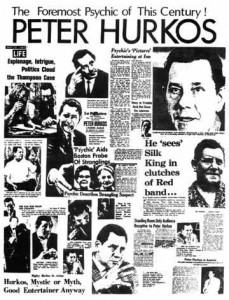Miercuri 29 ianuarie 1964, sergentul detectiv Lco Martin şi Bottomly l-au luat de la aeroport pe Peter Hurkos, în mare secret. Hurkos insistase asupra secretului, căci nu voia să fie deranjat de curioşi.
El i-a impresionat din prima clipă pe cei doi ofiţeri ai poliţiei din Boston. Stând împreună la o cafea, pe drum, Peter Hurkos l-a întrebat pe Martin : „Cine-i Katherine ?“ Era maică-sa, „Să-i spui“ a declarat Hurkos’ „să se ducă la doctor. Sunt îngrijorat de picioarele ei. Are nişte varice foarte rele. Să facă ce-i spune familia”.
Atât Martin cât şi restul familiei încercase s-o convingă pe femeie să meargă la spital, dar ea se încăpăţâna. Dar asta nu era tot. „E şi un lucru bun, Leo“ i-a mai spus Hurkos. „Bine că şi-a făcut ochelarii acum două luni. Are probleme mari cu ochiul stâng.“ Martin rămăsese cu gura căscată. Hurkos a continuat să-i povestească despre durerile de spate ale maică-sii şi cum acesta se lovise la vârsta de cinci ani.
Bottomly i-a spus lui Hurkos că ofiţerul lui de legătură va fi un anume Julian Soshnick, oferindu-se să i-l descrie pentru a-l putea recunoaşte. De fapt, Hurkos i l-a descris lui inclusiv faptul că era atât de mândru de părul lui încât nu purta pălărie. Cu tot scepticismul lui, Bottomly a fost impresionat. Chiar dacă Hurkos s-ar fi străduit să aflt şi să memoreze atâtea detalii despre colegii lui şi familiile lor, cum de putea şti atâtea despre Soshnick ? Acesta nu făcea parte din echipă, nu lucrase la cazul Sugrumătorului şi fusese desemnat doar în ultima clipă, dintr-un efectiv de 43 de anchetatori. Bottomly îl cooptase în echipă în timp ce Hurkos se afla deja în avion !
Hurkos şi-a început investigaţia a doua zi. S-a folosit de psihometrie (,,citirea obiectelor”), care l-a „conectat“ cu scenele crimei prin atingerea unor obiecte şi fotografii legate de ele.
El şi-a trecut-mâinile peste trei sute de fotografii de la aceste scene, a ales una din ele, declarând : „Asta-i falsă. Nu-i de aici!“ Soshnick a recunoscut că pusese fotografia, dintr-un caz deja rezolvat, printre celelalte pentru „control“.
Examinarea de către Hurkos a fotografiilor şi obiectelor (ciorapi, eşarfe, sutiene, alte haine) a fost uimitoare. Putea spune ce înfăţişau fotografiile fără a se uita la ele, a dcscris unele din scenele crimelor ca şi cum ar fi fost prezent, inclusiv detalii pe care poliţia nu le făcuse publice pentru a nu stânjeni cercetările.
In aceeaşi după amiază, unul dintre detectivi a întârziat, spunând că avusese o pană la maşină. Hurkos s a învârtit în jurul lui şi a început următorul uimitor monolog : ,,N-ai întârziat de maşină. Ai întârziat că te-ai dus la regulat. Crezi că glumesc, nu ? Dacă spun cum a fost, te strici de râs”. Apoi Hurkos a început să le povestească celorlalţi, arătând spre el; „La ăsta, şeful spune, acum două-trei ore : «Deci la Lexington, lucrezi cu ăla cu nebunu, Hurkos.»’-El zise: «Hai, şefu, am întâlnire, nu viu la lucru.» Şefu spune «ba vii». Aşa că, ce taci ? Dai telefon la fata şi spui «Scumpo, am de lucru după-amiază, nu pot să vin» şi fata spune «A, păi atunci vino acum, în drum spre lucru. Şi te duci la ea acasă, femeie faină, douăşopt, douăşnouă, divorţată, soţul i-a dat casa. Tu spui «Trebuie să lucrez cu ăla de citeşte gându’, cu şarlatanii’, cu Hurkos ăla». Aşa-i ? Aşa-i ? Ea zise : «Scumpule, până pleci, să-ţi fac o cafea,». Te duci cu ea în bucătărie, ea se apleacă la dulap după cafea, o tragi la tine, o pui pe masa din bucătărie şi-o regulezi. Aşa-i ?“
Se spune că a urmat o tăcere de moarte în timp a toţi aşteptau o replică a detectivului. Acesta însă, rămas cu ochii căscati, n-a mai putut articula nici un cuvânt.
De fapt, Hurkos s-a fixat asupra unui anume Thomas O Brien pe care l a considerat a fi Sugrumătorul, deşi unele din caracteristici se potriveau şi unui alt suspect anchetat de poliţie. Cazul n-a fost rezolvat ; în final, poliţia a acceptat mărturia depusă de un anume Altert DcSalvo, care a dat informaţii detaliate despre scenele crimei, pe care nu le-ar fi putut da decât criminalul. DeSalvo n-a fost judecat pe considerente de boală mintală, dar a rămas în istorie ca fiind Sugrumătorul din Boston. Hurkos a continuat să susţină că nu era DeSalvo ci cel descoperit de el.
Poate că, totuşi, a fost DeSalvo, căci, în pofida insistenţelor lui Hurkos privind propriul lui suspect, DeSalvo avea nasul ascuţit, o cicatrice pe braţul stâng şi lucra cu motoare diesel, exact cum descrisese Hurkos.
Cazul lui Hurkos nu este unic. Un alt psihic a fost tot olandez, Gerard Oroiset. Ca şi Hurkos, el a făcut şi afirmaţii insuficient confirmate de realitate şi a dat şi ,,rateuri”. Totuşi, ,.loviturile” lui au fost impresionante. Intr-un astfel de caz, compania aeriană KLM i-a cerut să caute un copil pierdut. Croiset a răspuns pe loc, la telefon, că copilul murise, descriind călătoria în care a fost găsit cadavrul. L-a descris de asemenea pe criminal. A folosit de mai multe ori psihometria, cu fotografii şi haine. Deşi imperfecte, descrierile lui au fost în mare măsură corecte.
La sfârşitul anilor ’70, nordul Angliei a fost terorizat de un criminal în serie. In final a fost arestat, judecat şi condamnat, Peter Sutcliffe. Până la prinderea lui însă, poliţia, mass-media şi practic, toată lumea a foşti asaltată cu descrieri psihice ale ucigaşului, următoarei crime etc. Majoritatea erau atât de vagi încât nu depăşeau stadiul unor simple supoziţii. Totuşi, unul din cazuri a fost impresionant. Nella Jones a declarat ziarului Yorkshire Post că a avut o viziune a ucigaşului ; din varii motive, declaraţia ei n-a fost publicată — ei cooperau cu poliţia în ce priveşte publicitatea cazului — iar reporterul a reţinut pentru el informaţia. Doamna Jones n-a văzut totul exact, dar a prezis o crimă pentru 17 sau 27 noiembrie, crima petrecându-se pe 17
Hurkos l-a descris şi pe cel pe care-l considera a fi Sugrumătorul. Ar fi fost un bărbat de 1,67—1,70 m, în greutate de 60—65 kilograme, cu nas ascuţit, o cicatrice pe braţul stâng dint-un accident de muncă, căci lucra cu motoare diesel, avea o problemă la degetul cel mare şi dormea pe un pat fără saltea. Au urmat o mulţime de alte mici detalii.
Ea a mai spus că numele ucigaşului era Peter, că era şofer pe- un camion pe care era desenată litera C. Peier Sutcliffe era şofer la compania de transport „Clark”. Doamna Jones a mai spus că ucigaşul locuia în Bradford, pe o stradă la numărul 6. Adresa lui Sutcliffe era Brad ford, Garden Lane nr. 6, într-o casă cu poartă de fier iforjat şi cu trepte la intrare, asa cum o descrisese doamna Jones.




